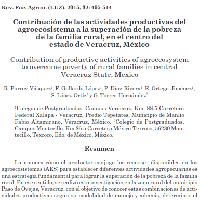Resumen
-
La manera cómo el productor conjuga los recursos disponibles en los agroecosistemas (AES) para establecer diferentes actividades agropecuarias es
una estrategia fundamental para lograr la superación de la pobreza de la familia rural. En ese sentido, se realizó esta investigación en la zona rural del municipio Paso de Ovejas, Veracruz, con el objetivo de conocer estas combinaciones de actividades productivas según su modalidad de manejo y además, determinar el autoconsumo como estrategia de un mayor bienestar familiar. Se entrevistaron 81 productores de un marco muestral de 1.834, por medio de un muestreo aleatorio estratificado. Se calculó la línea de pobreza humana (LPH) utilizando la ecuación lineal ajustada por Boltvinik y Marín y se utilizó correlación canónica para identificar las actividades que juegaron un papel preponderante para lograr superar la línea de pobreza. Se encontró, que los principales componentes de los agroecosistemas fueron caña de azúcar (Saccharum officinarum L.), ganadería de bovinos de doble propósito (Bos taurus x Bos indicus), maíz (Zea mays) y producción de traspatio. En general, los AES con mayor superficie y con capacidad de riego se dedicaron a la siembra de caña de azúcar y a la actividad ganadera, obteniendo mejores resultados económicos, menor autoconsumo y superando
la LPH; por el contrario, en los AES que presentaron menor superficie y caracterizados principalmente por la combinación de maíz y ganadería de baja productividad, mostraron menor cobertura de la LPH y mayor autoconsumo. Los productores que combinaron actividades productivas adaptadas a su entorno lograron un mayor grado de bienestar. - The way the producer joins the available resources in the agro-ecosystems(AES) to establish different agricultural activities is a main strategy to overcomethe poverty of the rural family. In this sense, this research was carried out in therural area of Paso de Ovejas, Veracruz, with the aim of knowing these combinationsof productive activities according to the handling modality, and also to determinethe auto-consumption as a strategy with more family wellness. Eighty oneproducers were interviewed from a sample of 1,834, using stratified randomizedsampling. The line of human poverty was calculated (LHP) using the linealequation adjusted by Boltvinik and Marín and canonic correlation was used toidentify the activities that had an important role to overcome poverty. It wasfound that the main components of the agro-ecosystems were sugar cane(Saccharum officinarum L.), double purpose cattle (Bos taurus x Bos indicus),corn (Zea mays) and backyard production. Generally, the AES with higher surfaceand irrigation capacity were committed to crop sugar cane and cattle activity,obtaining better economic results, less auto-consumption and surpassing theLHP; on the contrary, in the AES with less surface and mainly characterized bythe combination of corn and low cattle productivity, showed less cover of the LHPand more auto-consumption. The producers who combine productive activitiesadapted to their environment achieve more wellness.
